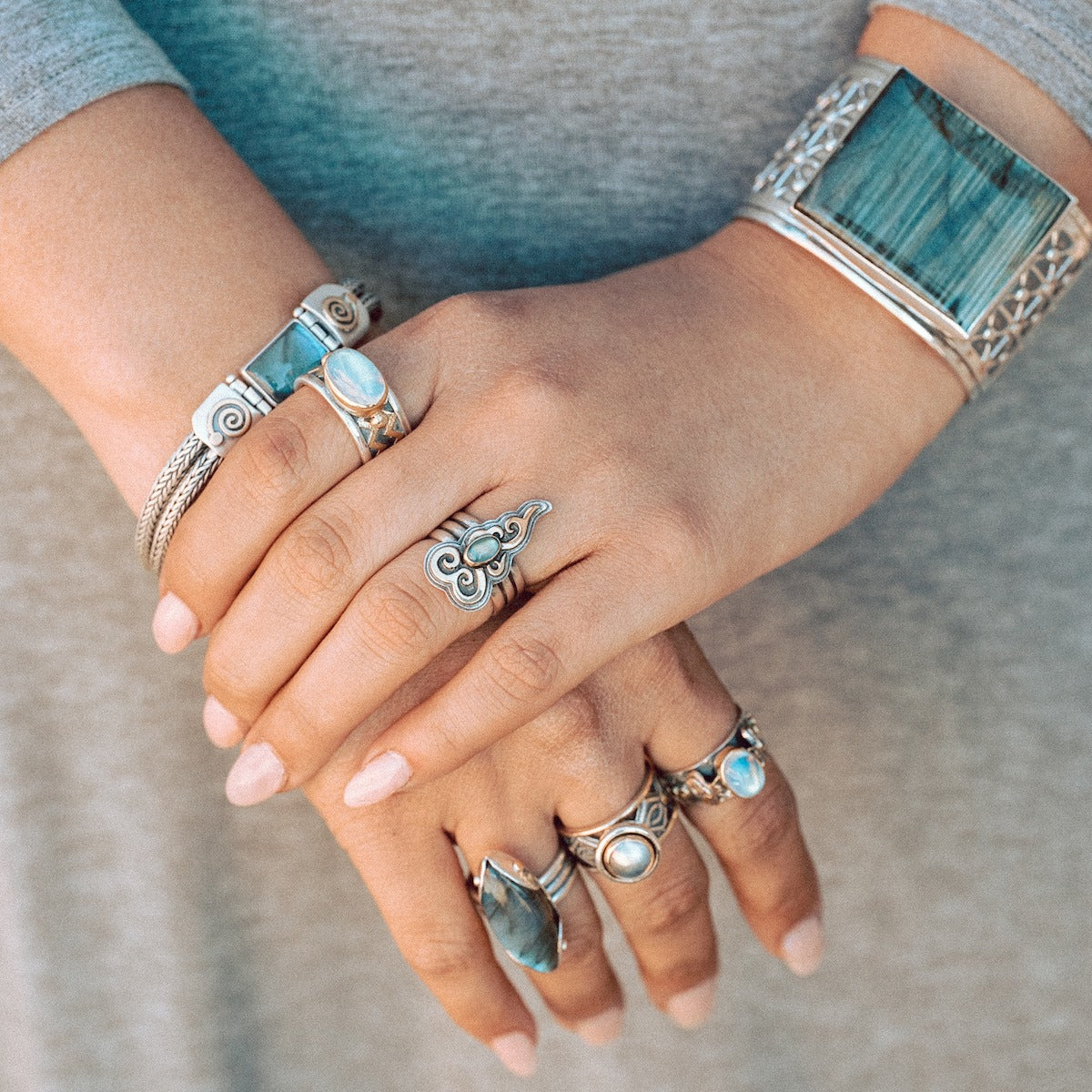March - Aquamarine
Celtic Birthstones
 Our Nautical ring features an aquamarine gemstone, set in two bands of 14K Gold around a Sterling Silver Band on top of a Silver base.
Our Nautical ring features an aquamarine gemstone, set in two bands of 14K Gold around a Sterling Silver Band on top of a Silver base.
The Myth and Lore of Aquamarine:
March's Birthstone
According to legend, Aquamarine originated in the treasure chest of the mermaids. This beautiful gem is March's birthstone, and has been reputed for ages to be a lucky stone for those who travel on or over water. Aquamarine carries the energy of courage and serenity, releasing anxiety and restlessness. Try using the mystical power of aquamarine to summon the dead, or for protection against demonic spirits, suggested Albertus Magnus, (1193-1280). (Kunth p. 24). But take heed that you engrave your talisman with the image of an eagle first, which can be easily done by your local practitioner of alchemy, who may also be known as the village fool. Aquamarine’s lore stretches back to the breast plate of the high priest Aaron>—each stone representing a quality of one of the tribes of Israel. (Kunth p. 319) St. John, in the fourteenth verse of Revelations, lists the "foundation" stones in the church, listing beryl as his eighth stone, associated with the virtue of mercy and the apostle Thomas. Aquamarine is part of the larger gem family known as beryl, which, depending upon trace chemicals, have color ranges in blue, pink, green and yellow. Until the last hundred years, the traditional birthstone for March was bloodstone. Aquamarine's designation as March's birthstone was made in 1912 by a trade association of jewelers. No doubt that commercial rather than metaphysical interest motivated jewelers to change March's stone. Sorting through the poltergeist of beryl's lore can be confusing perhaps because there are many variations in the color of beryl, each of which having its own quality to these ancient writers. A writer describing the metaphysical properties of beryl might be giving us more insight into his personality than the actual gem. One theme which consistently shows up is beryl's association with 'clarity of vision'. The word, in Latin, for a magnifying glass is beryllus. Glasses, in German, is brille. In England during the 16th century, windows were known as berills and mirrors, as berral-glas. (Kunth p. 49.) Consider also, the name aqua marine: water of the ocean or sea. In the middle ages, beryl was a popular crystal used as an aid to oracle. Methods included placing the gem in a water bowl, or holding it above water by a thread—letters for words would be drawn out once a question was asked. Beryl is also the gemstone of Scorpio, a water sign known for deep seated emotional passion and the welding of power. The connection to water and Scorpion suggests emotional depth. Scorpio, a fixed water sign in the zodiac, does not represent the river or the spring, but rather the still depths of the emotional life. Also, consider the blue color of Aquamarine. Blue is associated with those in positions of authority: the blue suit of a business man, the uniforms of police and fire fighters. The color has something to do with alignment to truth and justice. If you are coming from your true center, connected to the power of clarity and universal law, evil spirits probably will not have much power in your life. Aquamarine has a structure that is hexagonal, which means it's connected to the number six. In a hexagon, two triangles are brought together to form a new shape that is more balanced in its nature. According to tradition, the number six represents Solomon's seal — a way of mediating and coming to resolution and balance after indecision. Again, the connection with judgment and universal law is confirmed by its very structure. What is really important, however, in your study of aquamarine is what the gem might teach you. If you have a piece, now it may be time for you to experience the energy of aquamarine for yourself. First, check in with yourself and see how you are feeling and make a note of it. Then, take a piece of aquamarine and hold it in your hand. See how it feels and what thoughts come into your mind or heart. Consider what you learn in light of some of the ancient stories and you may be surprised at what you discover. References: George Frederick Kunz, The Curious Lore of Precious Stones, New York; Dover Publications, Inc. 1913, 1971 edition. Bruce Knuth, Gems In Myth, Legends And Lore; Parachute, Colorado, Jewelers Press, 2007
Trending Now
- $161.00
$161.00- $161.00
- Unit price
- per
- $319.00
- $319.00
- Unit price
- per
- $103.00
- $103.00
- Unit price
- per
- $427.00
- $427.00
- Unit price
- per
- $103.00
$103.00- $103.00
- Unit price
- per
- From $780.00
- From $780.00
- Unit price
- per
- $389.00
- $389.00
- Unit price
- per
- $211.00
- $211.00
- Unit price
- per
- Choosing a selection results in a full page refresh.

